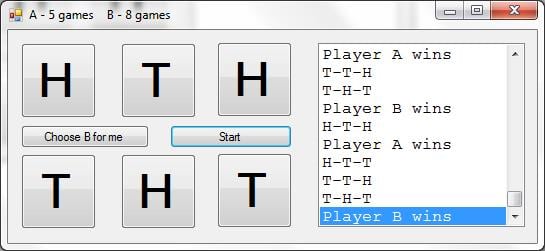Here's an interesting little scenario.
You get challenged to a game of coin toss. Both players pick a sequence of coin toss results (heads or tails). The coin is repeatedly tossed until the sequence for one of the players occurs. The loser pays the winner a dollar. You'd assume that you each have an equal chance of winning. However, using two little "tricks" you can tip the odds in your favour. The first trick is to always choose second. If you can manage this then your strategy is as follows:
Your first choice should be the opposite of your opponent's second choice.
Your second and third choices should be the same as your opponents first two choices.
The top three buttons are for player A, the bottom three for player B. You can set the choices manually by clicking the buttons. If you click on "Choose B for me" then player B will be set to the choices based on the above strategy. Each time you click "Start" a new game is played with the coin tosses and game results displayed in the listbox.
For the GUI, the top three buttons are named Button1, Button2 and Button3. The bottom three are Button4, Button5, and Button6. The remaining three controls are (buttons) btnChoose, btnStart, and (listbox) lbxResults.

